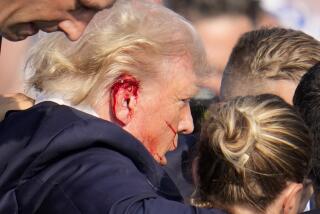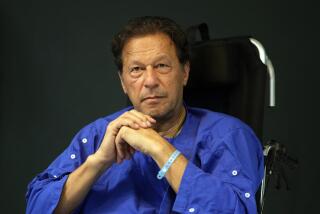Shots didn’t kill Bhutto, British say
- Share via
ISLAMABAD, PAKISTAN — In findings similar to those of the Pakistani government, Scotland Yard investigators asserted Friday that Benazir Bhutto died of a head injury resulting from the force of a suicide blast, not by shots fired toward her seconds earlier.
Although the report does not address broader questions of culpability in Bhutto’s death, the British investigators, who worked with Pakistani police, said for the first time that there was evidence the gunman who fired at Bhutto was the same person who triggered a powerful blast immediately after.
Initially, photographs and video of a man wrapped in a shawl standing next to the gunman had led investigators to theorize that there were two assailants.
The British team’s conclusions were sharply questioned by Bhutto’s Pakistan People’s Party, which argued that the investigators had too narrow a mandate and were hampered by a lack of crucial forensic evidence.
The findings were released at an emotionally fraught moment: the day after thousands of weeping mourners marked the end of the chehlum, or 40-day mourning period, following Bhutto’s death.
The 54-year-old opposition leader was killed Dec. 27, moments after leaving a campaign rally at a park in Rawalpindi, a garrison city near Islamabad, the Pakistani capital. She was riding in an armored vehicle, but stood up to wave to supporters as she drove away, with her head and shoulders protruding through the roof’s escape hatch.
The report, released 10 days before crucial parliamentary elections Feb. 18, could heighten an already volatile atmosphere in advance of the vote. Bhutto had returned to Pakistan in October to lead her party in the elections, which were originally scheduled to take place Jan. 8 but were postponed after riots broke out in the assassination’s aftermath.
Limited mandate
The Scotland Yard team spent 2 1/2 weeks investigating the attack after President Pervez Musharraf, under heavy domestic and international pressure, agreed to accept outside help in the inquiry. A poll taken weeks after the assassination indicated that nearly half the Pakistani public believed elements of the government or security services were complicit in some way in the killing.
The British investigators acknowledged that they were limited in their inquiry by the lack of an autopsy on Bhutto and by the loss of physical evidence that occurred when Pakistani authorities hosed down the bomb scene shortly after the attack.
“Nevertheless, the evidence that is available is sufficient for reliable conclusions to be drawn” regarding the cause of death, says the report, which was released by the British High Commission, or embassy, in Islamabad.
The report cites a pathologist from the British Home Office, Dr. Nathaniel Cary, as saying the only “tenable cause” of Bhutto’s fatal injury was hitting her head on the lip of the escape hatch of her armored vehicle as she was propelled sideways by the force of the blast.
The investigators wrote that high explosives “typically used in this sort of device” would have detonated at a velocity of 6,000 to 9,000 meters per second, generating “significantly more force than would be necessary” for the fatal blow to Bhutto’s head.
The British team was given the task of looking at forensic and technical evidence, rather than tackling the larger question of who organized and financed the attack.
“The Scotland Yard terms of reference were very limited,” said Sherry Rehman, a party spokeswoman who was with Bhutto on the night of the killing and said at the time that she believed the former prime minister had been shot. “We need to talk about the hidden hand as well.”
The party repeated its call for a United Nations investigation -- an appeal that Musharraf has repeatedly rebuffed.
Before her death, Bhutto had written to Musharraf and named several current and former Pakistani officials she said should be investigated in the event of her assassination.
Pakistani officials emphasized that the findings regarding the cause of death did not mark the end of their own investigation.
Four people have been arrested in connection with Bhutto’s killing, and the government has blamed Baitullah Mahsud, a pro-Taliban commander based in the tribal borderlands, for orchestrating the attack -- a charge the militant leader has denied.
“Absolutely, we are independently and impartially continuing to investigate this case,” said Abdul Majid, the Pakistani police official in charge of the case.
Autopsy controversy
The lack of an autopsy has been a particularly contentious issue. Bhutto’s husband, Asif Ali Zardari, who has taken over the party leadership in accordance with her wishes, refused permission for one on the tumultuous night of her death, saying it would be a desecration, and she was buried the following day.
In the absence of an autopsy, the team of attending doctors at Rawalpindi General Hospital had written in medical records that Bhutto died of “an open head injury with depressed skull fracture” but did not say what had caused it.
Pakistani law requires that an autopsy be performed in all cases of homicide, and party officials said the authorities should have insisted on one.
“The police are responsible for that,” senior party member Aitzaz Ahsan, a prominent lawyer who is under house arrest but was briefly freed for a medical appointment, told reporters in the eastern city of Lahore.
Musharraf has said publicly that hosing down of the crime scene was an error in judgment by local officials, not a deliberate attempt to destroy evidence.
The British investigators said they relied on X-rays of Bhutto’s skull and meticulous frame-by-frame examination, using enhancement technology, of photographs and video of the shooting and bombing.
The conclusion that the gunman and the bomber were the same man was based in part on the fact that only one set of remains -- believed to belong to the bomber -- has not been identified. Video images also showed him glancing downward after firing the shots but just before the explosion, the investigators said.
“In essence, all the evidence indicates that one suspect . . . fired the shots before detonating an improvised explosive device,” the report says.
--
More to Read
Sign up for Essential California
The most important California stories and recommendations in your inbox every morning.
You may occasionally receive promotional content from the Los Angeles Times.













